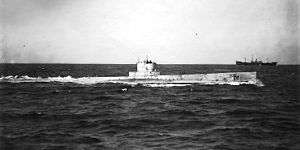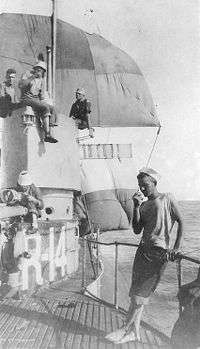USS R-14 (SS-91)
USS R-14 (SS-91) was an R-class coastal and harbor defense submarine of the United States Navy. Her keel was laid down by the Fore River Shipbuilding Company, in Quincy, Massachusetts, on 6 November 1918. She was launched on 10 October 1919 sponsored by Ms. Florence L. Gardner and commissioned on 24 December 1919, with Lieutenant Vincent A. Clarke, Jr., in command.
 | |
| History | |
|---|---|
| Name: | USS R-14 |
| Ordered: | 29 August 1916 |
| Builder: | Fore River Shipbuilding, Quincy, Massachusetts |
| Laid down: | 6 November 1918 |
| Launched: | 10 October 1919 |
| Commissioned: | 24 December 1919 |
| Decommissioned: | 7 May 1945 |
| Stricken: | 19 May 1945 |
| Fate: | Sold, 28 September 1945; scrapped, 1946 |
| General characteristics | |
| Type: | R-class submarine |
| Displacement: |
|
| Length: | 186 ft 2 in (56.74 m) |
| Beam: | 18 ft (5.5 m) |
| Draft: | 14 ft 6 in (4.42 m) |
| Installed power: |
|
| Propulsion: | |
| Speed: |
|
| Range: |
|
| Test depth: | 200 ft (61 m) |
| Complement: | 2 officers and 27 men |
| Armament: |
|
Service history
1919–1929
After a shakedown cruise off the New England coast, R-14 moved to New London, Connecticut, where she prepared for transfer to the Pacific Fleet. In May, she headed south. Given hull classification symbol "SS-91" in July, she transited the Panama Canal in the same month and arrived at Pearl Harbor on 6 September. There, for the next nine years, she assisted in the development of submarine and anti-submarine warfare tactics, and participated in search and rescue operations.

R-14 — under acting command of Lieutenant Alexander Dean Douglas – ran out of usable fuel and lost radio communications in May 1921 while on a surface search mission for the seagoing tug Conestoga about 100 nmi (120 mi; 190 km) southeast of the island of Hawaii. Since the submarine's electric motors did not have enough battery power to propel her to Hawaii, the ship's engineering officer Roy Trent Gallemore came up with a novel solution to their problem. Lieutenant Gallemore decided they could try to sail the boat to the port of Hilo, Hawaii. He therefore ordered a foresail made of eight hammocks hung from a top boom made of pipe bunk frames lashed firmly together, all tied to the vertical kingpost of the torpedo loading crane forward of the submarine's superstructure. Seeing that this gave R-14 a speed of about 1 kn (1.2 mph; 1.9 km/h), as well as rudder control, he ordered a mainsail made of six blankets, hung from the sturdy radio mast (top sail in photo). This added .5 kn (0.58 mph; 0.93 km/h) to the speed. He then ordered a mizzen made of eight blankets hung from another top boom made of bunk frames, all tied to the vertically placed boom of the torpedo loading crane. This sail added another .5 kn (0.58 mph; 0.93 km/h). Around 12:30 pm on 12 May, Gallemore was able to begin charging the boat's batteries.[2] After 64 hours under sail at slightly varying speeds, R-14 entered Hilo Harbor under battery propulsion on the morning of 15 May 1921. Douglas received a letter of commendation for the crew's innovative actions from his Submarine Division Commander, CDR Chester W. Nimitz, USN.[3]
1930–1946
On 12 December 1930, R-14 cleared Pearl Harbor for the last time and headed back to the Atlantic. Proceeding via San Diego, and the Panama Canal, she returned to New London on 9 February 1931, and through the end of the decade conducted training exercises for the Submarine School. In the spring of 1941, she moved down the coast to Key West, Florida, her homeport as of 1 June. In the fall, she returned to New London for overhaul and on 22 November resumed operations out of Key West. Into April 1945, she conducted training exercises for the Sound School and patrolled the Yucatán Channel and the Florida Straits. On 25 April, she headed north and in early May arrived at Philadelphia.
R-14 was decommissioned on 7 May, struck from the Naval Vessel Register on 19 May, and sold on 28 September to Rossoff Brothers of New York City. She was later resold to the Northern Metals Company of Philadelphia, and scrapped in 1946.
References
- The man in the foreground of the photo is Seaman First Class Raymond R. Seuss from Minneapolis, Minnesota. Though the copy shown of this photo is from the National Archives and in Public Domain the original of this photo has been in the Suess family possession until recently and is now in private hands.
- All log book entries detailing his unique engineering solutions to the ship's lack of fuel, were made by engineering officer Lt. Roy Trent Gallemore as documented in the reproduction of the log book in the Polk County Historical Quarterly, Volume 19, June 1992, Number 1
- Condensed from the log book of USS R-14. The logbook and Nimitz's letter are in the possession of Lieutenant Douglas's grandson, in Colorado. (2 April 2009)
- This article incorporates text from the public domain Dictionary of American Naval Fighting Ships. The entry can be found here.
External links
- Photo gallery of USS R-14 at NavSource Naval History
- 1939 Photos of R-14 from Life Magazine
- PigBoats.COM the R Boats